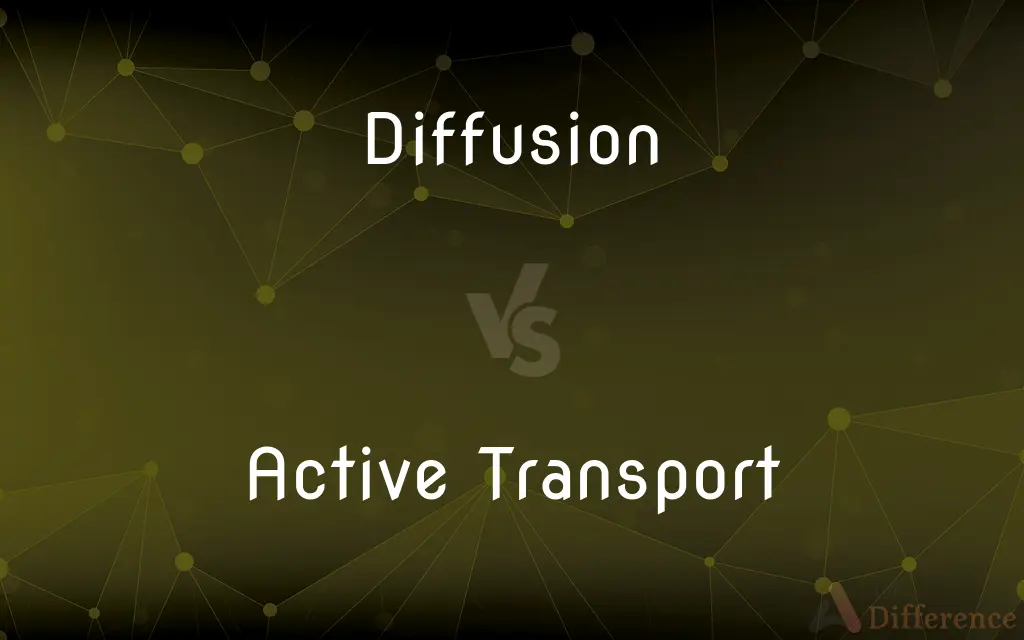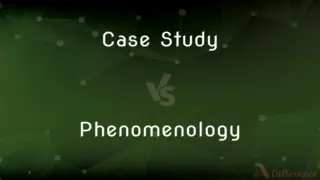Diffusion vs. Active Transport — What's the Difference?
By Tayyaba Rehman — Published on October 24, 2023
Diffusion is the passive movement of particles from high to low concentration. Active Transport is the movement of molecules across a membrane from low to high concentration using energy.

Difference Between Diffusion and Active Transport
Table of Contents
ADVERTISEMENT
Key Differences
Diffusion refers to a process where particles move from an area of higher concentration to an area of lower concentration until equilibrium is reached. Active Transport, however, involves the movement of substances across a membrane from a region of lower concentration to a region of higher concentration, which typically requires energy, often in the form of ATP.
Diffusion does not require external energy to proceed, relying instead on the intrinsic kinetic energy of particles. In contrast, active transport explicitly requires external energy input to move substances against their concentration gradients, making it energetically costly.
Diffusion is generally a slower process as it is driven by random particle movement and may not be efficient in transporting materials over longer cellular distances. On the other hand, active transport, being an energy-driven process, can rapidly transport substances even against their concentration gradient, ensuring timely delivery of essential molecules.
Diffusion can occur in any medium, be it gas, liquid, or through a solid and does not necessarily involve cellular membranes. Whereas active transport is predominantly a biological process, occurring at cellular membranes to facilitate the transfer of ions and molecules in and out of cells.
Diffusion results in substances moving towards a state of equilibrium, aiming to equalize the concentration across a given space. Active transport maintains or establishes disequilibrium, deliberately concentrating substances in a particular area, often for specific cellular functions.
ADVERTISEMENT
Comparison Chart
Energy Requirement
Does not require external energy
Requires external energy
Direction of Movement
High to low concentration
Low to high concentration
Speed of Process
Generally slower
Can be rapid
Occurrence Medium
Can occur in gas, liquid, or solid
Typically across cellular membranes
Equilibrium Role
Moves towards equilibrium
Can create/maintain disequilibrium
Compare with Definitions
Diffusion
Diffusion is a process of passive particle movement.
The diffusion of perfume filled the room.
Active Transport
Active Transport maintains cellular disequilibrium.
Active transport ensures high calcium ions outside of cells.
Diffusion
Diffusion seeks to equalize concentration.
Diffusion causes sugar to spread evenly in a stirring cup of coffee.
Active Transport
Active Transport is selective and regulated.
Active transport selectively uptakes necessary nutrients into the cell.
Diffusion
The process of diffusing or the condition of being diffused
The diffusion of new technology around the world.
Active Transport
Active Transport requires energy to function.
Active transport uses ATP to pump ions across the cell membrane.
Diffusion
The scattering of incident light by reflection from a rough surface.
Active Transport
Active Transport involves specific membrane transporters.
Glucose is moved by active transport into some cells.
Diffusion
The transmission of light through a translucent material.
Active Transport
Active Transport moves against the gradient.
In neurons, sodium-potassium pumps perform active transport.
Diffusion
The spontaneous intermingling of the particles of two or more substances as a result of random thermal motion.
Diffusion
The spread of linguistic or cultural practices or innovations within a community or from one community to another.
Diffusion
The act of diffusing or dispersing something, or the property of being diffused or dispersed; dispersion.
Diffusion
(physics) The scattering of light by reflection from a rough surface, or by passage through a translucent medium.
Diffusion
(physics) The intermingling of the molecules of a fluid due to random thermal agitation.
Gaseous diffusion
Diffusion
The spread of cultural or linguistic practices, or social institutions, in one or more communities.
Diffusion
(marketing) The gradual spread and adoption of goods or services.
Diffusion
Exchange of airborne media between regions in space in an apparently random motion of a small scale.
Diffusion
The movement of water vapor from regions of high concentration (high water vapor pressure) toward regions of lower concentration.
Diffusion
The act of diffusing, or the state of being diffused; a spreading; extension; dissemination; circulation; dispersion.
A diffusion of knowledge which has undermined superstition.
Diffusion
The act of passing by osmosis through animal membranes, as in the distribution of poisons, gases, etc., through the body. Unlike absorption, diffusion may go on after death, that is, after the blood ceases to circulate.
Diffusion
(physics) the process of diffusing; the intermingling of molecules in gases and liquids as a result of random thermal agitation
Diffusion
The spread of social institutions (and myths and skills) from one society to another
Diffusion
The property of being diffused or dispersed
Diffusion
The act of dispersing or diffusing something;
The dispersion of the troops
The diffusion of knowledge
Diffusion
Diffusion occurs without using energy.
Oxygen undergoes diffusion into the blood through lung membranes.
Diffusion
Diffusion can happen in various mediums.
Diffusion is evident when food coloring spreads in water.
Diffusion
Diffusion depends on particle kinetic energy.
Increased heat can speed up the diffusion of a substance in a solution.
Common Curiosities
What is active transport?
Active transport moves molecules across a membrane from low to high concentration using energy.
What is diffusion?
Diffusion is the passive movement of particles from a higher to a lower concentration.
Is energy required for diffusion?
No, diffusion does not require an external energy source.
Why does active transport require energy?
Active transport needs energy to move substances against their concentration gradient.
What is a key component active transport utilizes?
Active transport often utilizes transporter proteins in the cell membrane.
Where does active transport typically occur?
Active transport typically occurs across cellular membranes.
Does diffusion work against concentration gradients?
No, diffusion works with the concentration gradient, moving from high to low.
Can diffusion occur in biological systems?
Yes, diffusion can and does occur within and between cells in biological systems.
How does temperature affect diffusion?
Generally, increasing temperature increases the rate of diffusion.
What types of molecules are moved via active transport?
Various ions and molecules can be moved, including sodium, potassium, and glucose.
Can diffusion occur in any state of matter?
Yes, diffusion can occur in solids, liquids, and gases.
What energy currency is commonly used in active transport?
Adenosine triphosphate (ATP) is commonly used in active transport.
Can active transport create concentration imbalances?
Yes, active transport can create and maintain concentration gradients.
Can diffusion facilitate cellular uptake of nutrients?
Yes, diffusion can facilitate nutrient uptake when moving from higher to lower concentration.
Can diffusion cause molecules to concentrate in one area?
No, diffusion leads to a distribution of particles and does not create concentrated areas.
Share Your Discovery

Previous Comparison
Case Study vs. Phenomenology
Next Comparison
Access vs. EntranceAuthor Spotlight
Written by
Tayyaba RehmanTayyaba Rehman is a distinguished writer, currently serving as a primary contributor to askdifference.com. As a researcher in semantics and etymology, Tayyaba's passion for the complexity of languages and their distinctions has found a perfect home on the platform. Tayyaba delves into the intricacies of language, distinguishing between commonly confused words and phrases, thereby providing clarity for readers worldwide.












































